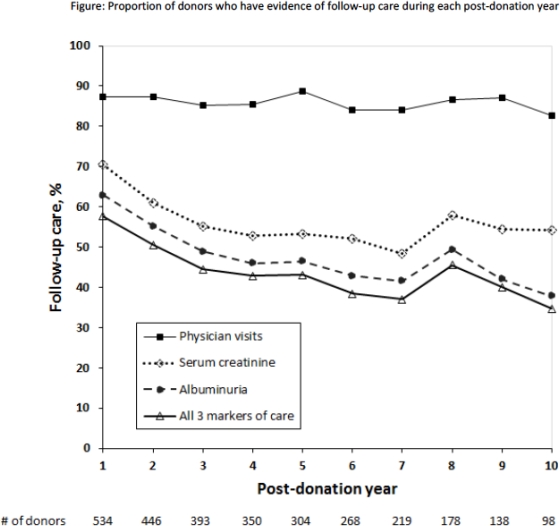Follow-Up Care of Living Kidney Donors
1University of Alberta, Edmonton, AB, Canada
2Saint Louis University, St. Louis, MO
3University of Calgary, Calgary, AB, Canada
4Western University, London, ON, Canada.
Meeting: 2018 American Transplant Congress
Abstract number: B161
Keywords: Donation, Glomerular filtration rate (GFR), Kidney transplantation, Monitoring
Session Information
Session Name: Poster Session B: Kidney Living Donor: Long Term Outcomes
Session Type: Poster Session
Date: Sunday, June 3, 2018
Session Time: 6:00pm-7:00pm
 Presentation Time: 6:00pm-7:00pm
Presentation Time: 6:00pm-7:00pm
Location: Hall 4EF
The 2017 KDIGO guidelines recommend that living kidney donors receive lifelong annual follow-up care to assess renal health, including serum creatinine measurements with glomerular filtration rate estimation and albuminuria measurement. Whether these best practice recommendations are currently being followed is unclear.
We conducted a retrospective study using linked databases in Alberta, Canada to identify and follow living kidney donors from 2002 to 2014. We determined the proportion of donors who had an annual outpatient physician visit and outpatient laboratory measurements for serum creatinine and albuminuria (urinalysis, protein-creatinine ratio, or albumin-creatinine ratio).
There were 534 living kidney donors with a median follow-up of 6.5 years (maximum 12.5 years). The median age at the time of donation was 41.5 years and 62% were female. Overall, 25% of donors had all three markers of care (physician visit, serum creatinine, and albuminuria measurement) in each year of follow-up. Adherence to annual physician visits was higher than serum creatinine or albuminuria measurements (67% vs. 32% vs. 29% of donors, respectively). In adjusted analyses, compared to donors who did not have guideline-concordant follow-up care, donors with guideline-concordant care were more likely to be older, resided closer to the transplant center, and received their nephrectomy in more recent years.
These findings suggest significant evidence-practice gaps, in that the majority of living kidney donors saw a physician annually, but the minority had measurements of kidney function or albuminuria. Future interventions should target improving follow-up care for all donors.
CITATION INFORMATION: Lam N., Lentine K., Hemmelgarn B., Klarenbach S., Quinn R., Lloyd A., Gourishankar S., Garg A. Follow-Up Care of Living Kidney Donors Am J Transplant. 2017;17 (suppl 3).
To cite this abstract in AMA style:
Lam N, Lentine K, Hemmelgarn B, Klarenbach S, Quinn R, Lloyd A, Gourishankar S, Garg A. Follow-Up Care of Living Kidney Donors [abstract]. https://atcmeetingabstracts.com/abstract/follow-up-care-of-living-kidney-donors/. Accessed December 12, 2025.« Back to 2018 American Transplant Congress

